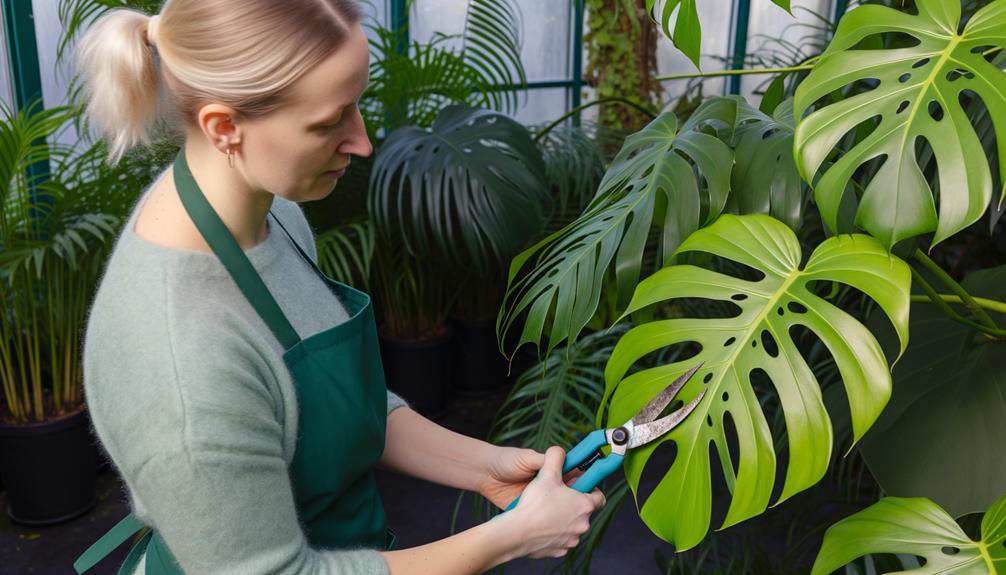Monstera Acacoyaguensis Pruning Techniques
To trim your Monstera Acacoyaguensis, utilize sterilized, sharp cutting shears. Initially, eliminate any lifeless, harmed, or infected leaves, cutting just above a leaf joint.
Concentrate on thinning out congested areas to enhance air circulation. The ideal time to trim is late winter to early spring when the plant is inactive and new growth hasn't begun.
Steer clear of trimming in autumn and winter. Employ bypass pruners, a sterilizing solution, and protective gloves for precise and secure cuts.
Consistent trimming every 4-6 weeks promotes healthier growth. With the correct method, you'll guarantee resilient and energetic new growth emerges.

Key Takeaways
- Prune Monstera Acacoyaguensis during late winter to early spring to promote healthy growth.
- Always use sterilized, sharp pruning shears to make clean cuts and prevent infections.
- Remove dead, damaged, or diseased leaves first to enhance overall plant health.
- Make cuts just above a leaf node to encourage new growth from the nodes.
- Thin out overcrowded areas to improve air circulation and light penetration.
Understanding Pruning Basics
To effectively prune your Monstera Acacoyaguensis, you must first grasp the fundamental principles of pruning. Begin by identifying the plant's growth pattern. Your goal is to promote healthy development and maintain its aesthetic appeal.
Use sterilized, sharp pruning shears to make clean cuts, which minimizes the risk of disease. Focus on removing dead, damaged, or diseased leaves first. Then, thin out overcrowded areas to enhance air circulation and light penetration. Cut just above a leaf node to stimulate new growth.
Always prune at an angle to prevent water from collecting on the cut surface, which can lead to rot. By understanding these basics, you'll guarantee your Monstera thrives, looks vibrant, and remains healthy.
Best Time to Prune
To determine the best time to prune your Monstera Acacoyaguensis, you'll need to take into account ideal seasonal conditions, understand the plant's growth cycle, and follow specific pruning frequency guidelines. Typically, pruning is most effective during the plant's active growth phase, which occurs in the spring and summer.
This guarantees the plant has ample energy to heal and encourages robust new growth.
Optimal Seasonal Conditions
For optimal pruning of Monstera acacoyaguensis, late winter to early spring is the perfect time, as the plant is still in its dormant phase and less vulnerable to stress. During this period, the plant's metabolic activities are minimal, reducing the risk of excessive sap loss and potential infection. Pruning during dormancy allows for faster recovery and encourages robust growth when the growing season resumes.
Confirm your cutting tools are sterilized to prevent pathogen transmission. Aim to prune just before new growth starts, which usually coincides with increasing daylight hours. This timing guarantees that the plant can allocate its resources effectively to heal the pruning wounds and produce new foliage.
Growth Cycle Understanding
Understanding the growth cycle of Monstera acacoyaguensis is essential for determining the best pruning times, ensuring the plant's energy is efficiently directed towards recovery and new growth. Monstera acacoyaguensis typically experiences active growth during spring and summer when light and temperature conditions are optimal.
Pruning during this period allows the plant to quickly heal and produce new foliage. Avoid pruning during the fall and winter months when the plant's growth slows, as this can stress the plant and impede recovery. Monitoring the plant's growth patterns will help you identify the ideal pruning window, maximizing both health and aesthetics.
Always use clean, sharp tools to minimize damage and the risk of disease.
Pruning Frequency Guidelines
Pruning Monstera acacoyaguensis should be done primarily during its active growth phase in spring and summer to guarantee maximum recovery and new foliage development. During this period, the plant's metabolic processes are at their peak for healing and regeneration.
Aim to prune once every 4-6 weeks, focusing on removing dead or damaged leaves and stems. Be sure to use sterilized, sharp pruning shears to make clean cuts, minimizing the risk of infection.
Avoid pruning in fall and winter as the plant's growth slows, and recovery becomes less effective. By following this schedule, you'll promote healthier growth patterns and enhance the plant's structural integrity.
Regular monitoring and timely interventions are essential for maintaining the plant's vitality and aesthetic appeal.
Essential Tools for Pruning
To effectively prune your Monstera Acacoyaguensis, you'll need a set of specific tools designed for precision and ease of use. Having the right tools guarantees clean cuts, minimizing stress on the plant and promoting healthy regrowth.
Here's a list of essential tools:
- Bypass Pruners: These are perfect for making clean cuts on thinner stems and leaves, reducing the risk of crushing plant tissue.
- Sterilizing Solution: Use isopropyl alcohol or a diluted bleach solution to disinfect your tools before and after pruning to prevent disease transmission.
- Protective Gloves: They safeguard your hands from potential irritants and provide a better grip, ensuring precision while handling sharp tools.
Equipping yourself with these tools sets the stage for effective and safe pruning practices.
Identifying Where to Cut
With your tools ready, you'll need to focus on pinpointing the precise locations on your Monstera Acacoyaguensis where cuts should be made to encourage robust growth and maintain the plant's health.
Start by examining the nodes, which are the points where leaves and aerial roots emerge from the stem. Aim to cut just above a node to promote new growth.
Also, identify any yellowing, damaged, or diseased leaves; removing these will prevent the spread of potential issues.
Additionally, look for overly long stems that disrupt the plant's balance. Trimming these back will help maintain a desirable shape.
Always make sure your cuts are clean and angled to minimize damage and optimize healing.
Step-by-Step Pruning Process
Begin by thoroughly inspecting your Monstera Acacoyaguensis, ensuring you identify all the nodes, damaged leaves, and overly long stems that require pruning to enhance the plant's overall health and aesthetics.
Next, prepare sterilized pruning shears to minimize the risk of disease transmission.
Follow these steps:
- Target Nodes: Cut just above a node to encourage new growth. Identify the node by a small bump where leaves and stems emerge.
- Remove Damaged Leaves: Trim any yellowing or diseased leaves at their base to prevent nutrient drainage.
- Shorten Long Stems: Prune overly long stems back to a node to maintain a compact and manageable plant shape.
Each cut should be clean and angled to promote effective healing and growth.
Managing Plant Health
Monitoring the health of your Monstera Acacoyaguensis involves vigilantly checking for pests, regularly assessing soil moisture levels, and providing appropriate fertilization.
Start by inspecting leaves for signs of pests like spider mites or aphids; use insecticidal soap if necessary.
Soil moisture is essential—water when the top inch of soil feels dry, avoiding both under- and over-watering to prevent root rot.
Fertilize monthly during the growing season with a balanced, water-soluble fertilizer, following the manufacturer's guidelines.
Prune dead or yellowing leaves promptly to prevent disease spread.
Additionally, make sure your plant receives bright, indirect light to support overall health.
Encouraging New Growth
To encourage new growth in your Monstera Acacoyaguensis, you should focus on pruning during ideal times, such as early spring and late summer.
Pay close attention to node care by ensuring cuts are clean and positioned just above a node to stimulate new shoots.
Regularly inspect the plant for any signs of disease or pests, as they can hinder growth despite proper pruning.
Optimal Pruning Times
Pruning your Monstera Acacoyaguensis at the onset of its growing season, typically in early spring, can greatly enhance its new growth and overall health. By targeting this period, you capitalize on the plant's natural surge in metabolic activity, promoting maximum recovery and growth.
To effectively time your pruning, consider these key aspects:
- Growth Patterns: Observe the plant's natural growth cycles to identify the beginning of the active phase.
- Environmental Conditions: Make sure temperatures are consistently above 55°F (13°C), as this encourages vigorous growth.
- Light Availability: Sufficient light levels during the early spring months will support robust photosynthesis and energy production.
Node Care Tips
As you finish pruning, focus on the nodes, which are critical points on the stem where leaves and roots emerge, to stimulate vigorous new growth. Inspect each node for health, verifying they're firm and free from discoloration. Apply rooting hormone to the nodes for better root development. Maintain humidity around the plant by misting or using a humidity tray.
| Node Care Step | Details |
|---|---|
| Inspect Nodes | Check for firmness and healthy coloration. |
| Apply Rooting Hormone | Promotes root development and growth. |
| Maintain Humidity | Mist leaves or use a humidity tray. |
| Monitor Light | Guarantee indirect light reaches the nodes. |
| Regular Watering | Keep soil moist but not waterlogged. |
Consistent care at the nodes fosters robust growth and overall plant health.
Common Pruning Mistakes
One common mistake when pruning Monstera acacoyaguensis is cutting too close to the node, which can damage the plant's ability to produce new growth.
To guarantee healthy pruning, consider these points:
- Cutting Too Close to the Node: Leave at least a quarter-inch above the node to avoid harming the growth point.
- Using Dull Tools: Always use sharp, sterilized pruning shears to make clean cuts and prevent infections.
- Ignoring Plant Health: Don't prune if the plant is stressed or unhealthy, as this can exacerbate issues and hinder recovery.
Paying attention to these details ensures your Monstera acacoyaguensis remains healthy and robust, ready to thrive with each strategic cut.
Understanding these common mistakes can considerably enhance your pruning technique.
Conclusion
Pruning your Monstera acacoyaguensis may seem challenging, but with the right techniques, you'll guarantee a healthier, more vibrant plant.
Remember, timing is essential—late winter or early spring is ideal. Use sharp, sanitized tools and make clean cuts just above nodes.
This not only enhances the plant's health but also promotes lush, new growth. Don't worry if you're new to pruning; practice makes perfect.
Embrace these steps, and you'll see your Monstera flourish like never before.





